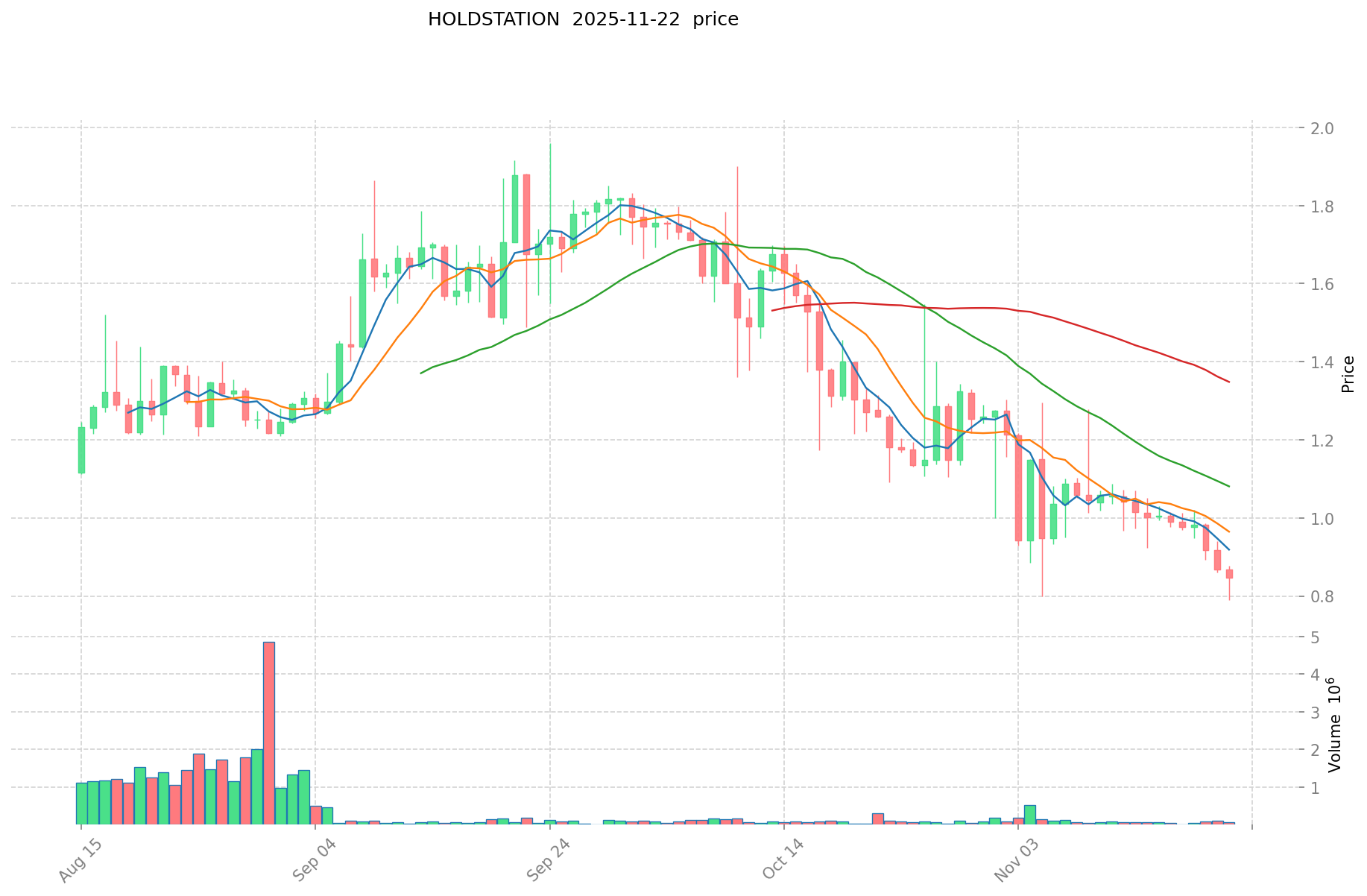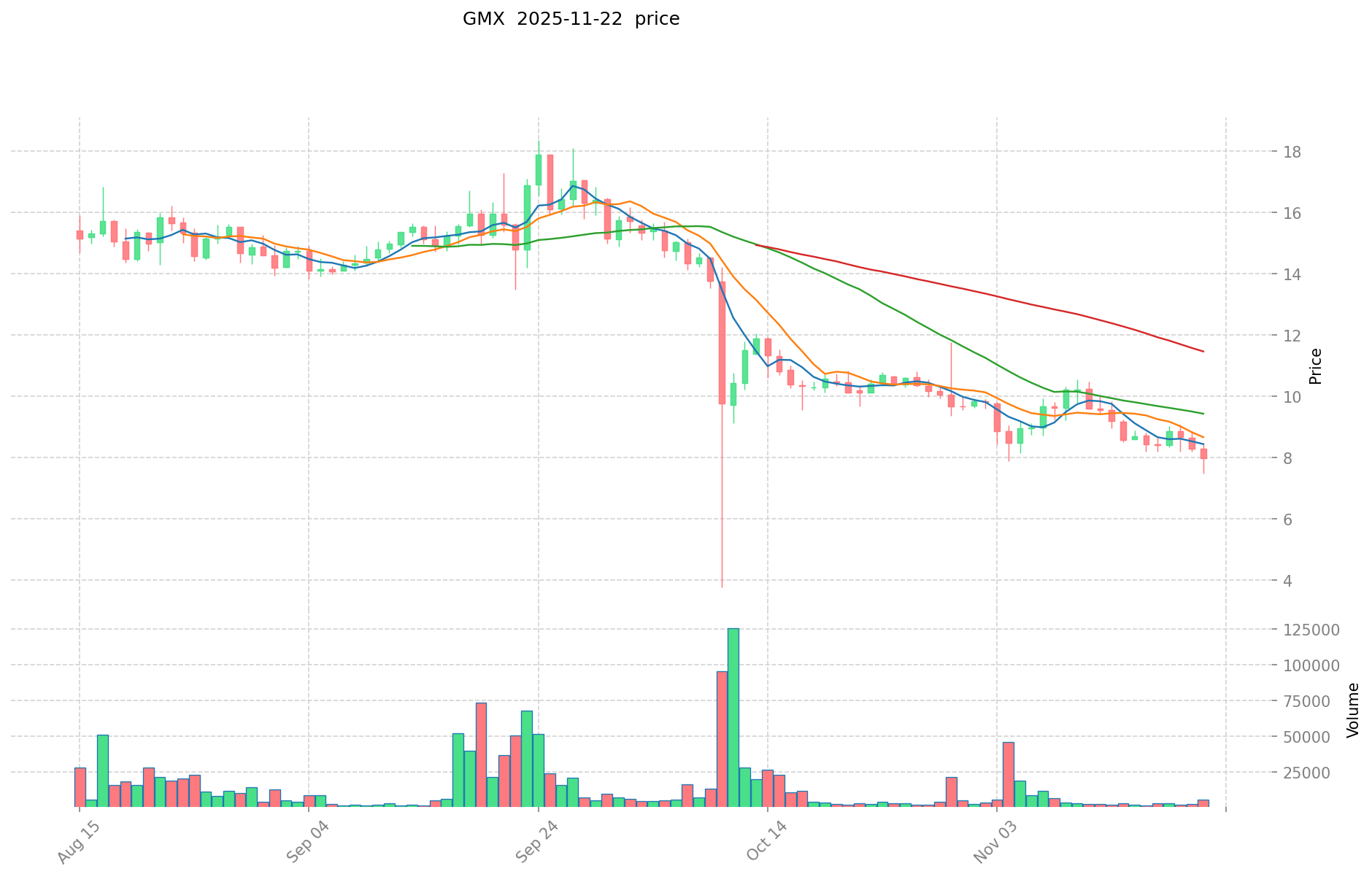HOLDSTATION vs GMX: Comparing Two Leading Crypto Exchanges for Optimal Trading Experience
Introduction: HOLDSTATION vs GMX Investment Comparison
In the cryptocurrency market, the comparison between HOLDSTATION vs GMX has been an unavoidable topic for investors. The two not only show significant differences in market cap ranking, application scenarios, and price performance, but also represent different positioning in the crypto asset space.
HOLDSTATION (HOLDSTATION): Since its launch, it has gained market recognition for its innovative Smart Contract Wallet for Futures Trading built on the zkSync Era.
GMX (GMX): Since its inception, it has been hailed as a decentralized and sustainable exchange, representing one of the prominent players in the decentralized perpetual trading space.
This article will provide a comprehensive analysis of the investment value comparison between HOLDSTATION and GMX, focusing on historical price trends, supply mechanisms, institutional adoption, technological ecosystems, and future predictions, attempting to answer the question most concerning to investors:
"Which is the better buy right now?"
I. Price History Comparison and Current Market Status
HOLDSTATION (Coin A) and GMX (Coin B) Historical Price Trends
- 2024: HOLDSTATION reached its all-time high of $16.445 on December 27, 2024.
- 2025: GMX hit its all-time low of $6.92 on October 11, 2025.
- Comparative analysis: In the current market cycle, HOLDSTATION dropped from its peak of $16.445 to a low of $0.647, while GMX declined from its all-time high of $91.07 to its current price of $7.982.
Current Market Situation (2025-11-22)
- HOLDSTATION current price: $0.8481
- GMX current price: $7.982
- 24-hour trading volume: HOLDSTATION $53,374.22 vs GMX $42,489.93
- Market Sentiment Index (Fear & Greed Index): 11 (Extreme Fear)
Click to view real-time prices:
- Check HOLDSTATION current price Market Price
- Check GMX current price Market Price


II. Core Factors Affecting Investment Value of HOLDSTATION vs GMX
Supply Mechanism Comparison (Tokenomics)
- HOLDSTATION: The protocol's token has a maximum supply cap of 100,000,000 HOLD tokens, following a deflationary model with 50% of trading fees used for buybacks and burns.
- GMX: Features a maximum supply cap of 13,250,000 GMX tokens with 30% of platform fees distributed to stakers.
- 📌 Historical pattern: Deflationary mechanisms like HOLDSTATION's burn program tend to create positive price pressure when trading volume increases.
Institutional Adoption and Market Applications
- Institutional holdings: GMX has greater institutional recognition with established presence in perpetual DEX markets, while HOLDSTATION is newer but gaining traction with its innovative AMM approach.
- Enterprise adoption: GMX is more widely integrated with existing DeFi protocols, while HOLDSTATION offers unique features like 0% price impact trades that appeal to institutional traders seeking efficiency.
- Regulatory attitudes: Both operate in similar regulatory environments as DeFi protocols, with neither having significant regulatory advantages over the other.
Technical Development and Ecosystem Building
- HOLDSTATION technical upgrades: Implementation of a novel AMM with concentrated liquidity that enables 0% price impact trades and up to 100x leverage with minimal slippage.
- GMX technical development: Established multi-chain perpetual DEX with real-yield tokenomics and oracle-based price feeds.
- Ecosystem comparison: GMX has a more mature ecosystem with established revenue streams and integrations, while HOLDSTATION offers innovations in trading mechanics with its concentrated liquidity pools and order book system.
Macroeconomic Factors and Market Cycles
- Performance in inflationary environments: Both protocols generate real yield from trading fees, providing potential inflation hedges.
- Macroeconomic monetary policy: Interest rate changes affect trading volumes on both platforms, with higher volatility environments typically benefiting derivatives exchanges.
- Geopolitical factors: Decentralized nature of both platforms makes them accessible globally, though GMX has wider market recognition across different regions.
III. 2025-2030 Price Prediction: HOLDSTATION vs GMX
Short-term Prediction (2025)
- HOLDSTATION: Conservative $0.67-$0.85 | Optimistic $0.85-$0.91
- GMX: Conservative $5.42-$7.97 | Optimistic $7.97-$8.29
Mid-term Prediction (2027)
- HOLDSTATION may enter a growth phase, expected price range $0.48-$0.96
- GMX may enter a bullish trend, expected price range $5.52-$11.38
- Key drivers: Institutional capital inflow, ETFs, ecosystem development
Long-term Prediction (2030)
- HOLDSTATION: Base scenario $1.37-$1.72 | Optimistic scenario $1.72-$1.95
- GMX: Base scenario $12.99-$13.58 | Optimistic scenario $13.58-$14.16
Disclaimer
HOLDSTATION:
| 年份 | 预测最高价 | 预测平均价格 | 预测最低价 | 涨跌幅 |
|---|---|---|---|---|
| 2025 | 0.914112 | 0.8464 | 0.668656 | 0 |
| 2026 | 0.93307136 | 0.880256 | 0.62498176 | 3 |
| 2027 | 0.9610635008 | 0.90666368 | 0.4805317504 | 6 |
| 2028 | 1.288731754752 | 0.9338635904 | 0.868493139072 | 10 |
| 2029 | 1.63360757868672 | 1.111297672576 | 0.92237706823808 | 31 |
| 2030 | 1.948882728396531 | 1.37245262563136 | 1.22148283681191 | 61 |
GMX:
| 年份 | 预测最高价 | 预测平均价格 | 预测最低价 | 涨跌幅 |
|---|---|---|---|---|
| 2025 | 8.29296 | 7.974 | 5.42232 | 0 |
| 2026 | 9.1094976 | 8.13348 | 5.2054272 | 1 |
| 2027 | 11.380365216 | 8.6214888 | 5.517752832 | 8 |
| 2028 | 12.50115876 | 10.000927008 | 6.90063963552 | 25 |
| 2029 | 14.73886617804 | 11.251042884 | 9.0008343072 | 40 |
| 2030 | 14.1645004388118 | 12.99495453102 | 9.6162663529548 | 62 |
IV. Investment Strategy Comparison: HOLDSTATION vs GMX
Long-term vs Short-term Investment Strategies
- HOLDSTATION: Suitable for investors focused on innovative trading mechanics and potential for high growth in emerging DeFi sectors
- GMX: Suitable for investors seeking established platforms with proven track records in decentralized perpetual trading
Risk Management and Asset Allocation
- Conservative investors: HOLDSTATION: 20% vs GMX: 80%
- Aggressive investors: HOLDSTATION: 60% vs GMX: 40%
- Hedging tools: Stablecoin allocation, options, cross-currency portfolios
V. Potential Risk Comparison
Market Risks
- HOLDSTATION: Higher volatility due to newer market position and innovative features
- GMX: Exposure to broader DeFi market trends and competition from other perpetual DEXes
Technical Risks
- HOLDSTATION: Scalability, network stability on zkSync Era
- GMX: Oracle reliability, smart contract vulnerabilities
Regulatory Risks
- Global regulatory policies may impact both platforms, with potential for increased scrutiny on decentralized derivatives trading
VI. Conclusion: Which Is the Better Buy?
📌 Investment Value Summary:
- HOLDSTATION advantages: Innovative AMM with concentrated liquidity, 0% price impact trades, high leverage potential
- GMX advantages: Established market presence, multi-chain support, proven revenue model
✅ Investment Advice:
- New investors: Consider a conservative allocation favoring GMX for its established track record
- Experienced investors: Explore a balanced portfolio with both HOLDSTATION and GMX to capture innovation and stability
- Institutional investors: Evaluate HOLDSTATION's unique features for potential alpha generation while maintaining significant exposure to GMX for liquidity and market depth
⚠️ Risk Warning: Cryptocurrency markets are highly volatile. This article does not constitute investment advice. None
VII. FAQ
Q1: What are the main differences between HOLDSTATION and GMX? A: HOLDSTATION is a newer platform offering innovative features like 0% price impact trades and concentrated liquidity AMM, while GMX is an established multi-chain perpetual DEX with a proven track record in decentralized trading.
Q2: Which platform has better tokenomics? A: HOLDSTATION has a deflationary model with 50% of trading fees used for buybacks and burns, while GMX distributes 30% of platform fees to stakers. Both models aim to create value for token holders, but HOLDSTATION's burn mechanism may create stronger positive price pressure during high trading volume periods.
Q3: How do the price predictions compare for HOLDSTATION and GMX? A: By 2030, HOLDSTATION is predicted to reach $1.37-$1.95 in optimistic scenarios, while GMX is expected to reach $12.99-$14.16. However, these predictions are speculative and subject to market conditions.
Q4: What are the main risks associated with investing in these platforms? A: Both face regulatory risks due to the evolving nature of DeFi regulations. HOLDSTATION may experience higher volatility and technical risks due to its newer status, while GMX faces risks related to oracle reliability and competition in the perpetual DEX space.
Q5: How should investors allocate their portfolio between HOLDSTATION and GMX? A: Conservative investors might consider 20% HOLDSTATION and 80% GMX, while aggressive investors could opt for 60% HOLDSTATION and 40% GMX. The allocation should be based on individual risk tolerance and investment goals.
Q6: What are the key factors that could drive growth for each platform? A: For HOLDSTATION, key growth factors include adoption of its innovative trading mechanics and expansion of its ecosystem. For GMX, continued multi-chain expansion, institutional adoption, and maintaining its position as a leading perpetual DEX are crucial growth drivers.
Share
Content